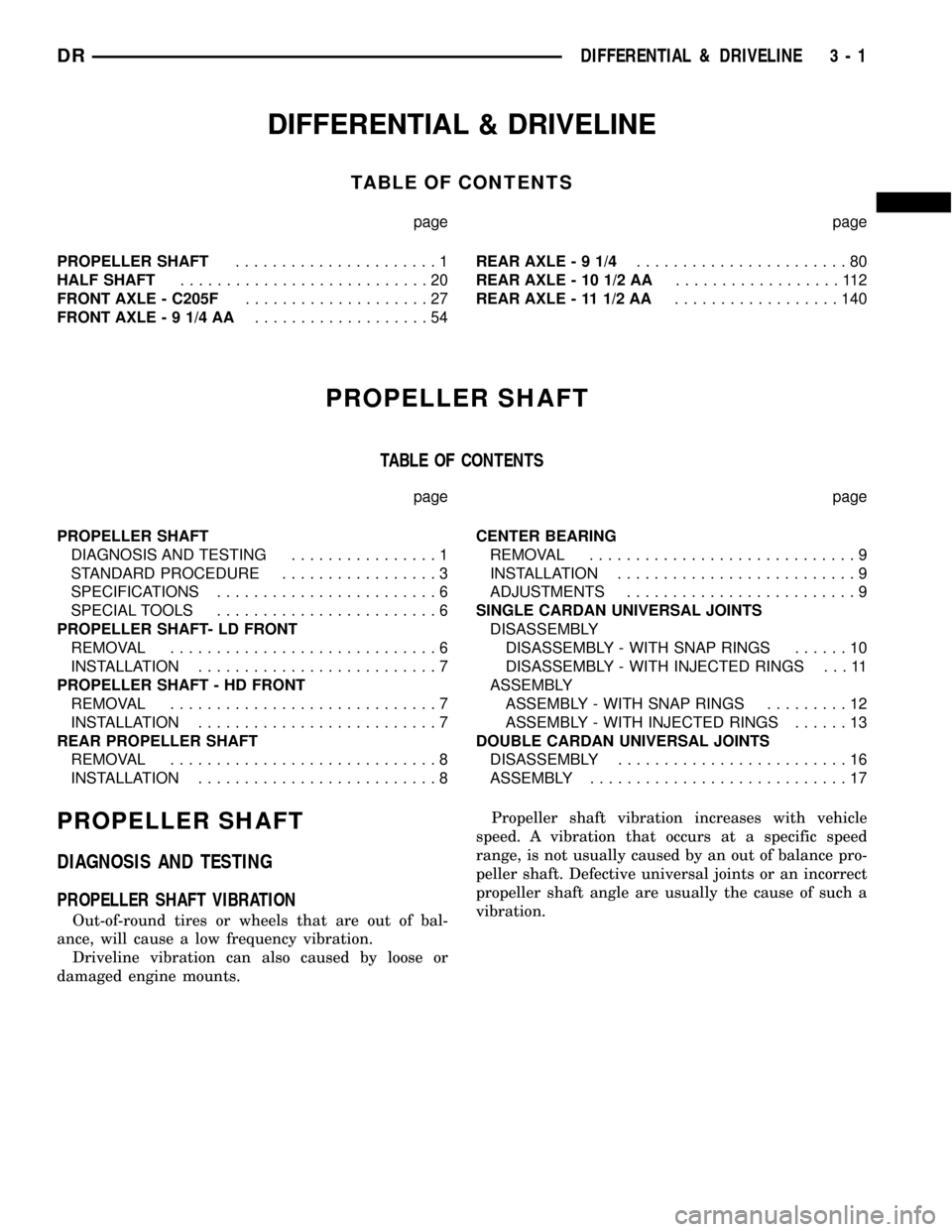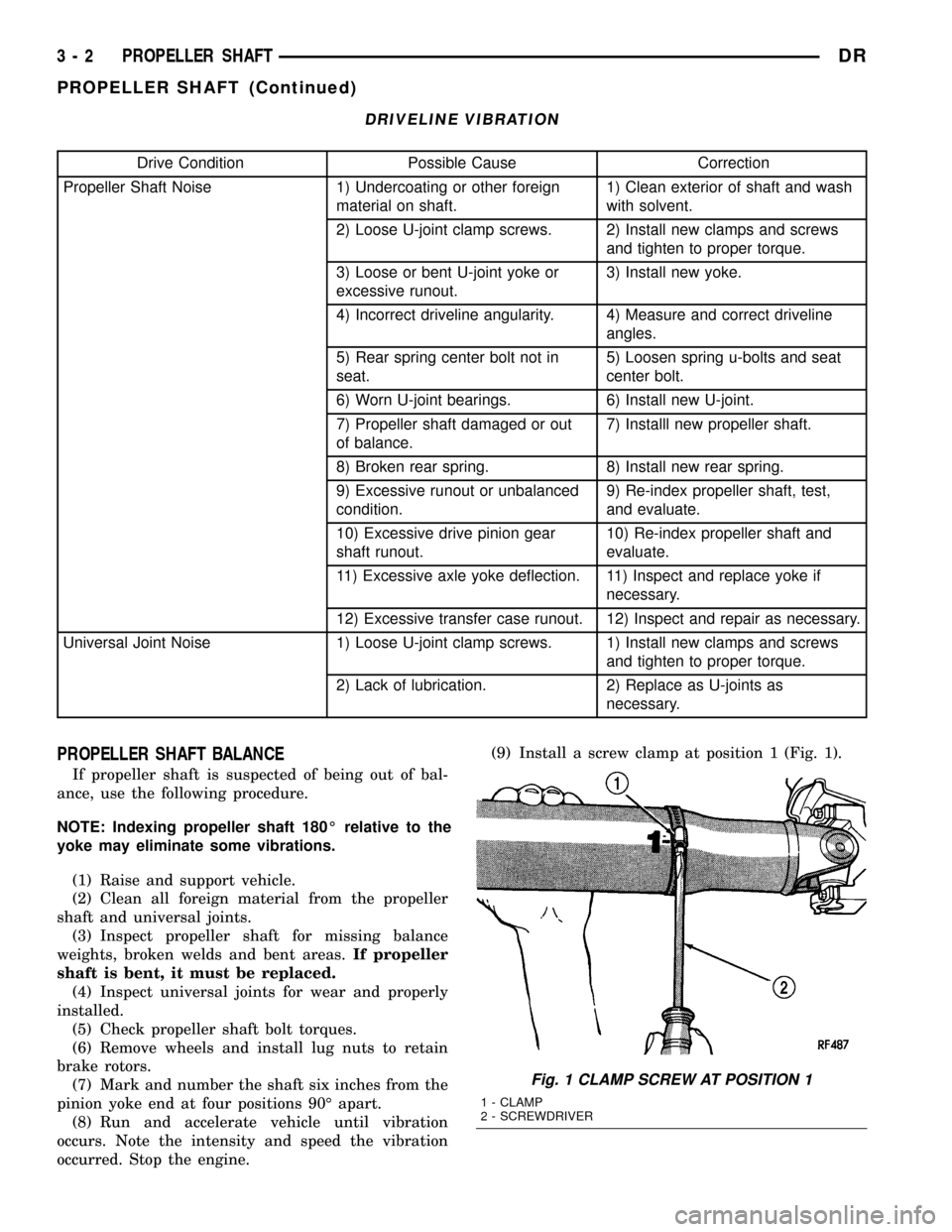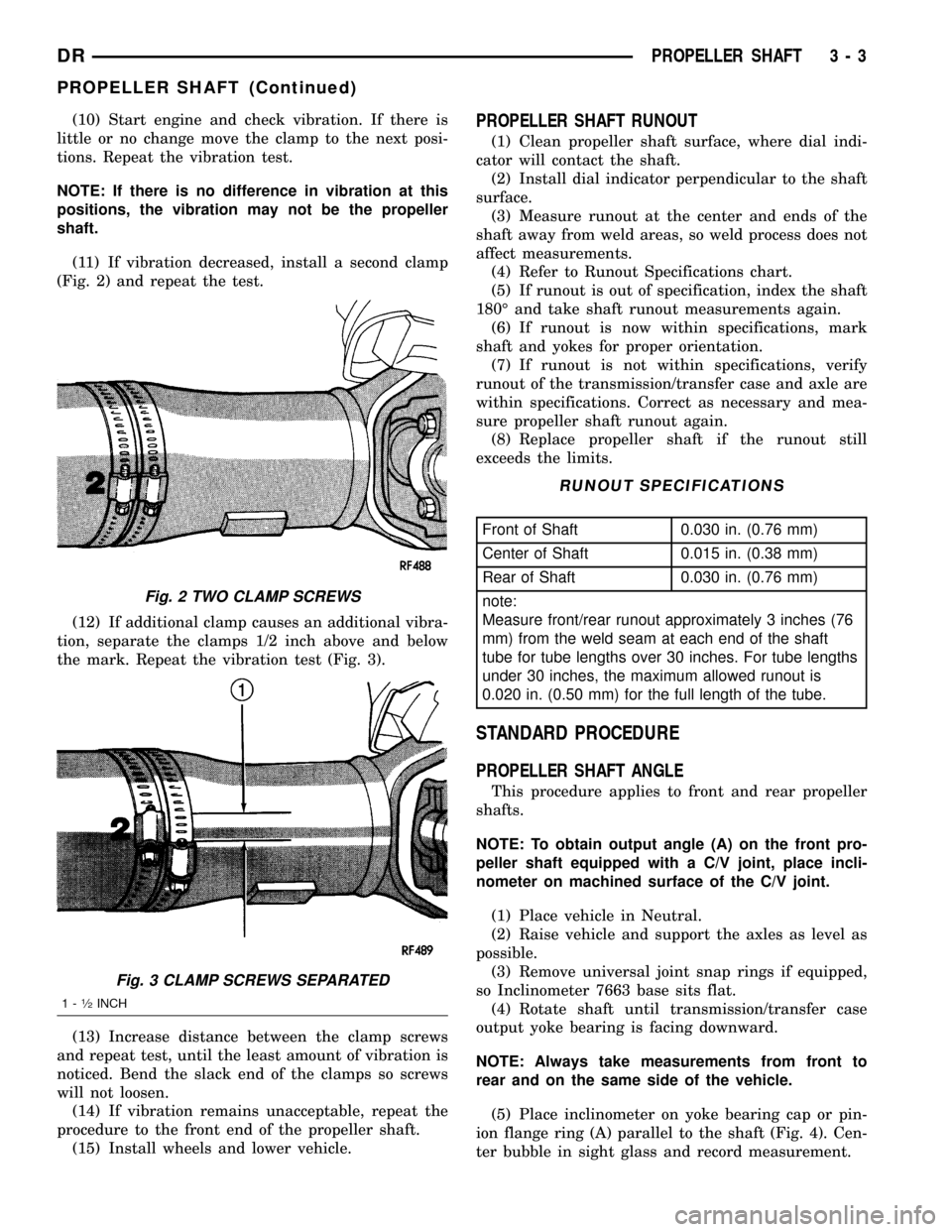1998 DODGE RAM 1500 Universal joint
[x] Cancel search: Universal jointPage 82 of 2627

DIFFERENTIAL & DRIVELINE
TABLE OF CONTENTS
page page
PROPELLER SHAFT......................1
HALF SHAFT...........................20
FRONT AXLE - C205F....................27
FRONT AXLE - 9 1/4 AA...................54REAR AXLE-91/4.......................80
REAR AXLE - 10 1/2 AA..................112
REAR AXLE - 11 1/2 AA..................140
PROPELLER SHAFT
TABLE OF CONTENTS
page page
PROPELLER SHAFT
DIAGNOSIS AND TESTING................1
STANDARD PROCEDURE.................3
SPECIFICATIONS........................6
SPECIAL TOOLS........................6
PROPELLER SHAFT- LD FRONT
REMOVAL.............................6
INSTALLATION..........................7
PROPELLER SHAFT - HD FRONT
REMOVAL.............................7
INSTALLATION..........................7
REAR PROPELLER SHAFT
REMOVAL.............................8
INSTALLATION..........................8CENTER BEARING
REMOVAL.............................9
INSTALLATION..........................9
ADJUSTMENTS.........................9
SINGLE CARDAN UNIVERSAL JOINTS
DISASSEMBLY
DISASSEMBLY - WITH SNAP RINGS......10
DISASSEMBLY - WITH INJECTED RINGS . . . 11
ASSEMBLY
ASSEMBLY - WITH SNAP RINGS.........12
ASSEMBLY - WITH INJECTED RINGS......13
DOUBLE CARDAN UNIVERSAL JOINTS
DISASSEMBLY.........................16
ASSEMBLY............................17
PROPELLER SHAFT
DIAGNOSIS AND TESTING
PROPELLER SHAFT VIBRATION
Out-of-round tires or wheels that are out of bal-
ance, will cause a low frequency vibration.
Driveline vibration can also caused by loose or
damaged engine mounts.Propeller shaft vibration increases with vehicle
speed. A vibration that occurs at a specific speed
range, is not usually caused by an out of balance pro-
peller shaft. Defective universal joints or an incorrect
propeller shaft angle are usually the cause of such a
vibration.
DRDIFFERENTIAL & DRIVELINE 3 - 1
Page 83 of 2627

DRIVELINE VIBRATION
Drive Condition Possible Cause Correction
Propeller Shaft Noise 1) Undercoating or other foreign
material on shaft.1) Clean exterior of shaft and wash
with solvent.
2) Loose U-joint clamp screws. 2) Install new clamps and screws
and tighten to proper torque.
3) Loose or bent U-joint yoke or
excessive runout.3) Install new yoke.
4) Incorrect driveline angularity. 4) Measure and correct driveline
angles.
5) Rear spring center bolt not in
seat.5) Loosen spring u-bolts and seat
center bolt.
6) Worn U-joint bearings. 6) Install new U-joint.
7) Propeller shaft damaged or out
of balance.7) Installl new propeller shaft.
8) Broken rear spring. 8) Install new rear spring.
9) Excessive runout or unbalanced
condition.9) Re-index propeller shaft, test,
and evaluate.
10) Excessive drive pinion gear
shaft runout.10) Re-index propeller shaft and
evaluate.
11) Excessive axle yoke deflection. 11) Inspect and replace yoke if
necessary.
12) Excessive transfer case runout. 12) Inspect and repair as necessary.
Universal Joint Noise 1) Loose U-joint clamp screws. 1) Install new clamps and screws
and tighten to proper torque.
2) Lack of lubrication. 2) Replace as U-joints as
necessary.
PROPELLER SHAFT BALANCE
If propeller shaft is suspected of being out of bal-
ance, use the following procedure.
NOTE: Indexing propeller shaft 180É relative to the
yoke may eliminate some vibrations.
(1) Raise and support vehicle.
(2) Clean all foreign material from the propeller
shaft and universal joints.
(3) Inspect propeller shaft for missing balance
weights, broken welds and bent areas.If propeller
shaft is bent, it must be replaced.
(4) Inspect universal joints for wear and properly
installed.
(5) Check propeller shaft bolt torques.
(6) Remove wheels and install lug nuts to retain
brake rotors.
(7) Mark and number the shaft six inches from the
pinion yoke end at four positions 90É apart.
(8) Run and accelerate vehicle until vibration
occurs. Note the intensity and speed the vibration
occurred. Stop the engine.(9) Install a screw clamp at position 1 (Fig. 1).
Fig. 1 CLAMP SCREW AT POSITION 1
1 - CLAMP
2 - SCREWDRIVER
3 - 2 PROPELLER SHAFTDR
PROPELLER SHAFT (Continued)
Page 84 of 2627

(10) Start engine and check vibration. If there is
little or no change move the clamp to the next posi-
tions. Repeat the vibration test.
NOTE: If there is no difference in vibration at this
positions, the vibration may not be the propeller
shaft.
(11) If vibration decreased, install a second clamp
(Fig. 2) and repeat the test.
(12) If additional clamp causes an additional vibra-
tion, separate the clamps 1/2 inch above and below
the mark. Repeat the vibration test (Fig. 3).
(13) Increase distance between the clamp screws
and repeat test, until the least amount of vibration is
noticed. Bend the slack end of the clamps so screws
will not loosen.
(14) If vibration remains unacceptable, repeat the
procedure to the front end of the propeller shaft.
(15) Install wheels and lower vehicle.PROPELLER SHAFT RUNOUT
(1) Clean propeller shaft surface, where dial indi-
cator will contact the shaft.
(2) Install dial indicator perpendicular to the shaft
surface.
(3) Measure runout at the center and ends of the
shaft away from weld areas, so weld process does not
affect measurements.
(4) Refer to Runout Specifications chart.
(5) If runout is out of specification, index the shaft
180É and take shaft runout measurements again.
(6) If runout is now within specifications, mark
shaft and yokes for proper orientation.
(7) If runout is not within specifications, verify
runout of the transmission/transfer case and axle are
within specifications. Correct as necessary and mea-
sure propeller shaft runout again.
(8) Replace propeller shaft if the runout still
exceeds the limits.
RUNOUT SPECIFICATIONS
Front of Shaft 0.030 in. (0.76 mm)
Center of Shaft 0.015 in. (0.38 mm)
Rear of Shaft 0.030 in. (0.76 mm)
note:
Measure front/rear runout approximately 3 inches (76
mm) from the weld seam at each end of the shaft
tube for tube lengths over 30 inches. For tube lengths
under 30 inches, the maximum allowed runout is
0.020 in. (0.50 mm) for the full length of the tube.
STANDARD PROCEDURE
PROPELLER SHAFT ANGLE
This procedure applies to front and rear propeller
shafts.
NOTE: To obtain output angle (A) on the front pro-
peller shaft equipped with a C/V joint, place incli-
nometer on machined surface of the C/V joint.
(1) Place vehicle in Neutral.
(2) Raise vehicle and support the axles as level as
possible.
(3) Remove universal joint snap rings if equipped,
so Inclinometer 7663 base sits flat.
(4) Rotate shaft until transmission/transfer case
output yoke bearing is facing downward.
NOTE: Always take measurements from front to
rear and on the same side of the vehicle.
(5) Place inclinometer on yoke bearing cap or pin-
ion flange ring (A) parallel to the shaft (Fig. 4). Cen-
ter bubble in sight glass and record measurement.
Fig. 2 TWO CLAMP SCREWS
Fig. 3 CLAMP SCREWS SEPARATED
1-1¤2INCH
DRPROPELLER SHAFT 3 - 3
PROPELLER SHAFT (Continued)
Page 86 of 2627

Fig. 7 UNIVERSAL JOINT ANGLE EXAMPLE
1 - 4.9É ANGLE (C)
2 - 3.2É ANGLE (B)
3 - INPUT YOKE4 - 3.0É ANGLE (A)
5 - OUTPUT YOKE
Fig. 8 UNIVERSAL JOINT ANGLE
1 - YOKES MUST BE IN SAME PLANE
DRPROPELLER SHAFT 3 - 5
PROPELLER SHAFT (Continued)
Page 91 of 2627

SINGLE CARDAN UNIVERSAL
JOINTS
DISASSEMBLY
DISASSEMBLY - WITH SNAP RINGS
(1) Tap outside of bearing cap with a drift to
loosen snap ring.
(2) Remove snap rings (1) from both sides of yoke
(Fig. 17).
(3) Position yoke with the grease fitting if
equipped, pointing up.
(4) Position a socket with a inside diameter large
enough to receive the bearing cap, beneath the yoke
on a press.
(5) Place another socket with an outside diameter
smaller than bearing cap on the upper bearing cap
and press (1) the lower cap through the yoke (Fig.
18).
NOTE: If the bearing cap will not pull out of the
yoke by hand after pressing, tap the yoke ear near
the bearing cap to dislodge the cap.
(6) Pull bearing cap of the yoke.
(7) Turn yoke over in the press and straighten the
cross (1). Press the cross until the remaining bearing
cap (2) can be removed (Fig. 19).
CAUTION: If cross or bearing cap are not straight
during removal, the bearing cap will score the walls
of the yoke bore and damage can occur.
Fig. 17 SNAP RING
1 - SNAP RING
Fig. 18 PRESS OUT BEARING
1 - PRESS
2 - SOCKET
Fig. 19 PRESS OUT REMAINING BEARING
1 - CROSS
2 - BEARING CAP
3 - 10 PROPELLER SHAFTDR
Page 92 of 2627

DISASSEMBLY - WITH INJECTED RINGS
(1) Place shaft yoke in vise.
(2) Position U-joint press (1) with receiver (2) on
propeller shaft yoke (Fig. 20).
(3) Pressed U-joint bearing caps (1) out of shaft
yoke (2) (Fig. 21).
(4) Remove lower bearing cap from shaft yoke.
(5) Turn shaft over and position press (1) with
receiver (2) on shaft yoke (Fig. 22).(6) Press remaining U-joint bearing cap out of
shaft yoke.
(7) Remove flange (1) with U-joint out of shaft
yoke (2) (Fig. 23).
(8) Position U-joint press (2) with receiver (1) on
flange (Fig. 24).
(9) Press U-joint bearing caps (1) out of flange (2)
(Fig. 25).
(10) Remove bearing cap on the outside of the
flange.
Fig. 20 PRESS ON YOKE
1 - PRESS
2 - RECEIVER
Fig. 21 BEARING OUT OF YOKE
1 - BEARING CAPS
2 - YOKE
Fig. 22 PRESS REMAINING BEARING
1 - PRESS
2 - RECEIVER
Fig. 23 FLANGE WITH U-JOINT
1 - FLANGE
2 - YOKE
DRPROPELLER SHAFT 3 - 11
SINGLE CARDAN UNIVERSAL JOINTS (Continued)
Page 93 of 2627

(11) Position U-joint press (2) with receiver (1) on
flange (Fig. 26).
(12) Press remaining U-joint bearing cap out of
flange.
(13) Remove U-joint from flange.
ASSEMBLY
ASSEMBLY - WITH SNAP RINGS
(1) Apply (EP) N.L.G.I. Grade 1 or 2 grease to
inside of yoke bores.
Fig. 24 PRESS ON FLANGE
1 - RECEIVER
2 - PRESS
Fig. 25 BEARING OUT OF FLANGE
1 - BEARINGS
2 - FLANGE
Fig. 26 REMAINING BEARING
1 - RECEIVER
2 - PRESS
Fig. 27 CROSS IN YOKE
1 - CROSS
2 - YOKE
3 - 12 PROPELLER SHAFTDR
SINGLE CARDAN UNIVERSAL JOINTS (Continued)
Page 94 of 2627

(2) Position cross (1) in yoke with lube fitting
pointing up, if equipped (Fig. 27).
(3) Place a bearing cap (1) over the cross end (2)
and align cap with yoke bore (Fig. 28).
(4) Press bearing cap into the yoke bore enough to
clear snap ring groove.
(5) Repeat Step 3 and Step 4 to install the oppo-
site bearing cap.
NOTE: If joint is stiff or binding, strike the yoke with
a soft hammer to seat the needle bearings.
(6) Add grease to lube fitting, if equipped.
(7) Install propeller shaft.ASSEMBLY - WITH INJECTED RINGS
NOTE: Replacement joint has internal snap rings.
(1) Place joint in flange with one bearing cap.
(2) Position press (3) with receiver (1) on flange
and bearing cap (2) (Fig. 29).
Fig. 28 BEARING AND CROSS
1 - BEARING CAP
2 - CROSSFig. 29 PRESS ON FLANGE
1 - RECEIVER
2 - BEARING
3 - PRESS
Fig. 30 SNAP RING GROOVE
1 - YOKE
2 - GROOVE
DRPROPELLER SHAFT 3 - 13
SINGLE CARDAN UNIVERSAL JOINTS (Continued)